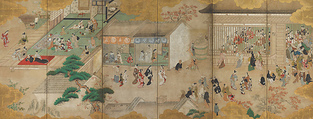Returned to lender The Met accepts temporary loans of art both for short-term exhibitions and for long-term display in its galleries.
Autumn in the Yoshiwara; Cherry Blossom Viewing Party
Hishikawa Morohira Japanese
Not on view
Autumn in the Yoshihara: This screen presents a view of a street in the Yoshiwara, Edo’s licensed pleasure quarter. Curious men, some wearing large hats to conceal their identities, gaze into the latticed room of a brothel where lower caste courtesans are on display. A high-ranking courtesan is taking an afternoon stroll with her whole retinue, showing herself in front of two teahouses (ageya) where one newly-arrived samurai is just giving up his sword and another, hiding his face behind a fan, is already in conversation with a courtesan who has come there to meet him. In the inn at far left, courtesans are helping their guests to enjoy the pleasures of being away from daily life with its many restrictions and responsibilities. The autumn setting is indicated by red maples, bush clover, and chrysanthemums interspersed throughout.
Cherry Blossom Viewing Party: This screen shows people enjoying the arrival of spring under blossoming cherry trees. On the left, a noblewoman has set up a celebration party curtained off from the public. She has left the enclosure briefly to welcome a young woman arriving in a palanquin with her aged chaperone. Her friends are dancing and drinking sake, some already too drunk to stand, playing the game of go or simply enjoying the outing, while others are dancing joyfully in line to the music of musicians seated comfortably on rugs. A similar pair of screens painted by Morohira is in the Idemitsu Museum in Tokyo.
A similar pair of screens painted by Morohira is in the Idemitsu Museum in Tokyo. Their Yoshiwara screen bears a hidden signature on the painting hanging in the inn’s tokonoma at the far left that reads “Yamato eshi Hishikawa Morohira” (Yamato-e painter, Hishikawa Morohira). Morohira, was a pupil of Hishida Moronobu (1618–1694), and was active during the Genroku and Hōei eras (1688–1711). His painting style is characterized by chubby figures, and is representative of the style of Miyagawa Chōshun (1682–1752).
This image cannot be enlarged, viewed at full screen, or downloaded.
This artwork is meant to be viewed from right to left. Scroll left to view more.



